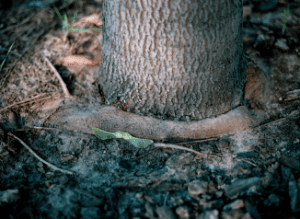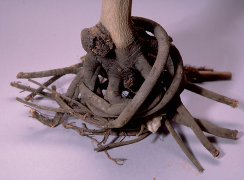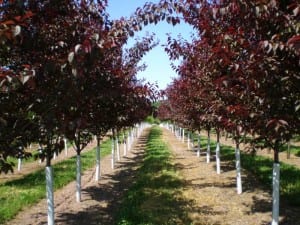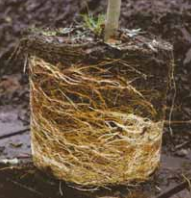Every year, millions of urban trees die prematurely or are removed due to infrastructure damage and/or public safety concerns caused by poorly managed roots. This problem is largely a result of improper planting techniques, and although specific causes vary, there are some particular issues that account for the majority of issues – one of which is dysfunctional root systems.
It’s an undeniable fact that we need trees in our cities. But preventing tree roots from interfering with utilities and other infrastructure in an ongoing issue.
Conflictions between urban tree root growth and paved surfaces are constraining the development of healthy and productive trees in our cities. Millions of dollars each year are spent on pavement repair and damage mitigation, that could rather be spent improving tree health. These conflicts also reflect a downsizing of urban tree canopy and the loss of benefits associated with a diminishing urban forests.
So why do the roots of urban trees become so problematic, and what are dysfuntional root systems doing to the health of trees?
Arborists and researchers regularly study failing trees for signs of disease, insect damage, and other stresses, in an attempt to establish why trees are failing so that measures can be adopted to help future tree populations. Obvious areas of examination such as leaves and bark are aspects that offer important information into the health of a tree. Not so obvious underground aspects of an examination however, can present equally as crucial knowledge into why a tree may be failing, and prove how some trees are being strangled by their own roots.
Flawed root systems and inadequate planting practices can shorten a tree’s lifespans by as much as 80% (The Underground Epidemic Killing our Trees). This confirms the old saying that “trees that are ugly above ground are usually even uglier below ground”. It’s the ugly belowground conditions that the University of Minnesota’s research was determined to uncover.
Gary Johnson, a professor of urban forestry at the University of Minnesota, realized that in many cases the tree’s root flare (the area that the base of the trunk merges with the roots) were buried unusually low and the roots were wrapping around the buried trunk, making it difficult for water and nutrients to access the tree later in life.
This problem is referred to as stem-girdling roots. A stem-girdling root is a type of dysfunctional root that is growing against a tree’s trunk, squeezing or compressing the stem (The Underground Epidemic Killing our Trees). They encircle or run tangential to a tree’s stem, eventually compressing the woody and nonwoody tissues of the stem (Gary Johnson). This occurs when the trunk flare is buried deep in the soil. Circling roots tend to grow close to the surface near the trunk, and hence wrap around the trunk flare area.


Photos: A Practitioner’s Guide to Stem Girdling Roots of Trees
The degree to which trees are impacted varies with severity of root encirclement, site growing conditions, weather, age, and size of tree. In some cases, trees have completely snapped at the point of constriction.
Research was determining that such problems were being found in field-grown balled and burlapped trees, as well as container-grown trees – meaning that the issue couldn’t be traced to a single production method. It was recognized as a widespread problem usually originating at point of early growth in the nursery (Gary Watson & Angela Hewitt, Morton Arboretum).
To prevent these disasters from occurring, landscape architects and related professionals must demand better planting and nursery growing practices. Planting specifications should display the top of the root ball flush with the ground, and should direct the contractor to remove any soil above the trunk flare and main roots, as well as any girdling roots, before planting.

Appropriate nursery planting and growing conditions are crucial
In past years, nursery trees were usually grown in fields and later transplanted with bare roots, making it easy for the grower to inspect the roots and plant the tree properly with main roots and developing trunk flare close to the surface. It’s now common for containers to be used for the growing process, even to start the growth of what are claimed to be field-grown trees.
Girdling and other root swirl issues occurs in container-grown trees when a root reaches the wall and curves in a new direction to continue its growth. This curve forces the root to grow in a circle along the planter wall.

Photo: Gary Johnson, University of Minnesota
Container planted trees must have roots pruned when transplanting to larger planters in order for the root system to release the impression of the smaller container. Even still, root swirl may still continue in the larger planter, creating numerous sets of circling roots.
“Urban trees are already subject to continual natural and manmade stresses,
which are all conditions that deviate from optimal growth.
Stem-girdling roots add another layer of significant stress on a tree”
Planting specifications for container-grown trees should address not only girdling roots, but also the removal of fine roots forming in a thick mat above the main roots – as these can become future girdling roots. The detail should also demonstrate how to prune roots on the outer edge of the root ball so that all cuts leave root stubs in a radial pattern to the trunk.
Research has indicated that although pruning these outer edge roots may appear to damage the root ball, trees are not harmed by this harsh pruning if they are irrigated immediately. The new roots should start by growing out from the root ball in a radial fashion, producing a healthier, more stable tree.
The use of root management systems to encourage root establishment in intended rooting areas and away from paved surfaces and utilities is also a large part of healthy tree growth – but this will be covered in another part of the “Managing the Root of the Problem” series.
In closing, although urban foresters and arborists make valiant efforts to extend the useful lifespan of problem trees, the conflicts they endure with hardscaped areas often results in the premature removal of trees. When proper urban tree planting systems are used, these issues cease to exist.
